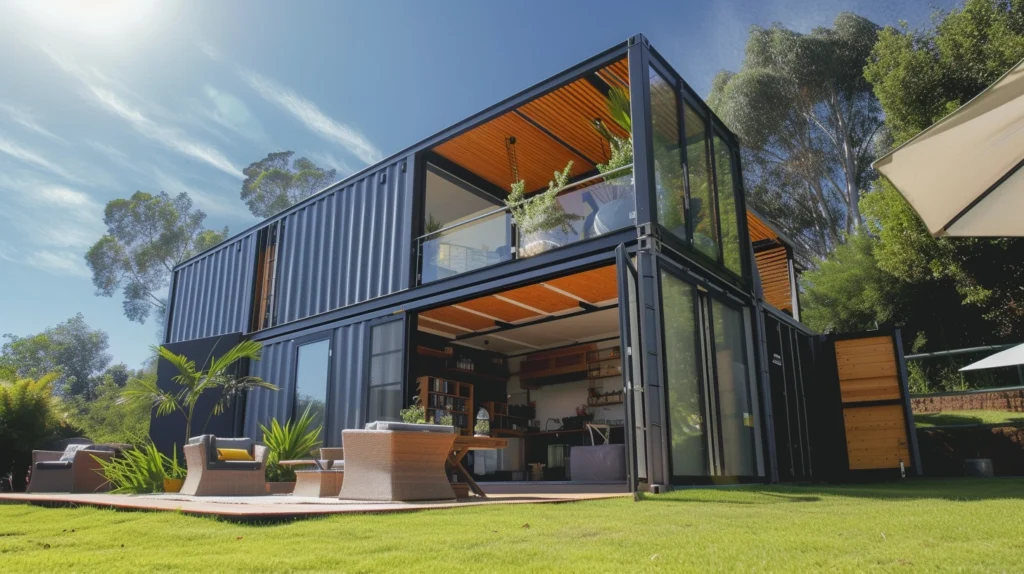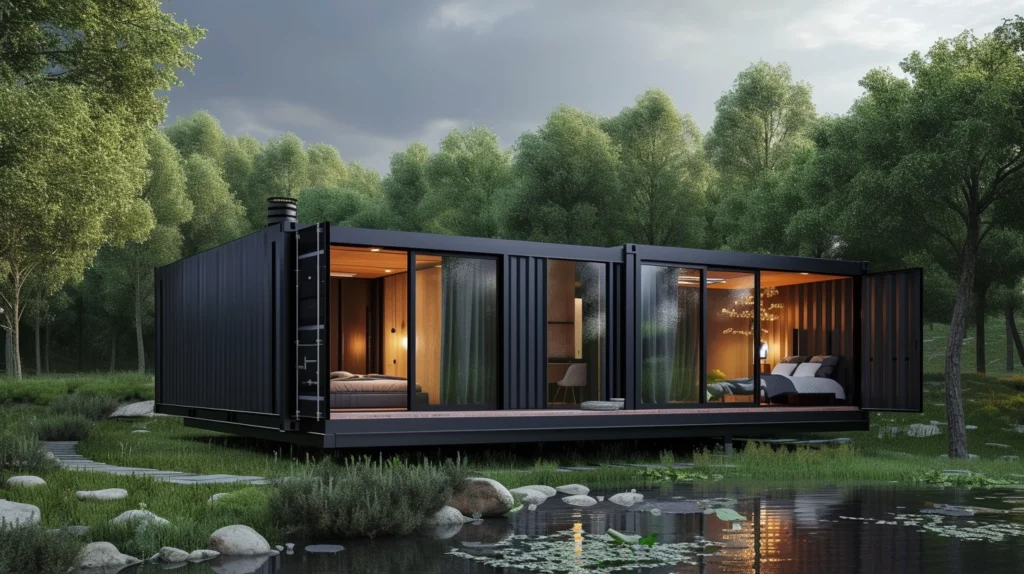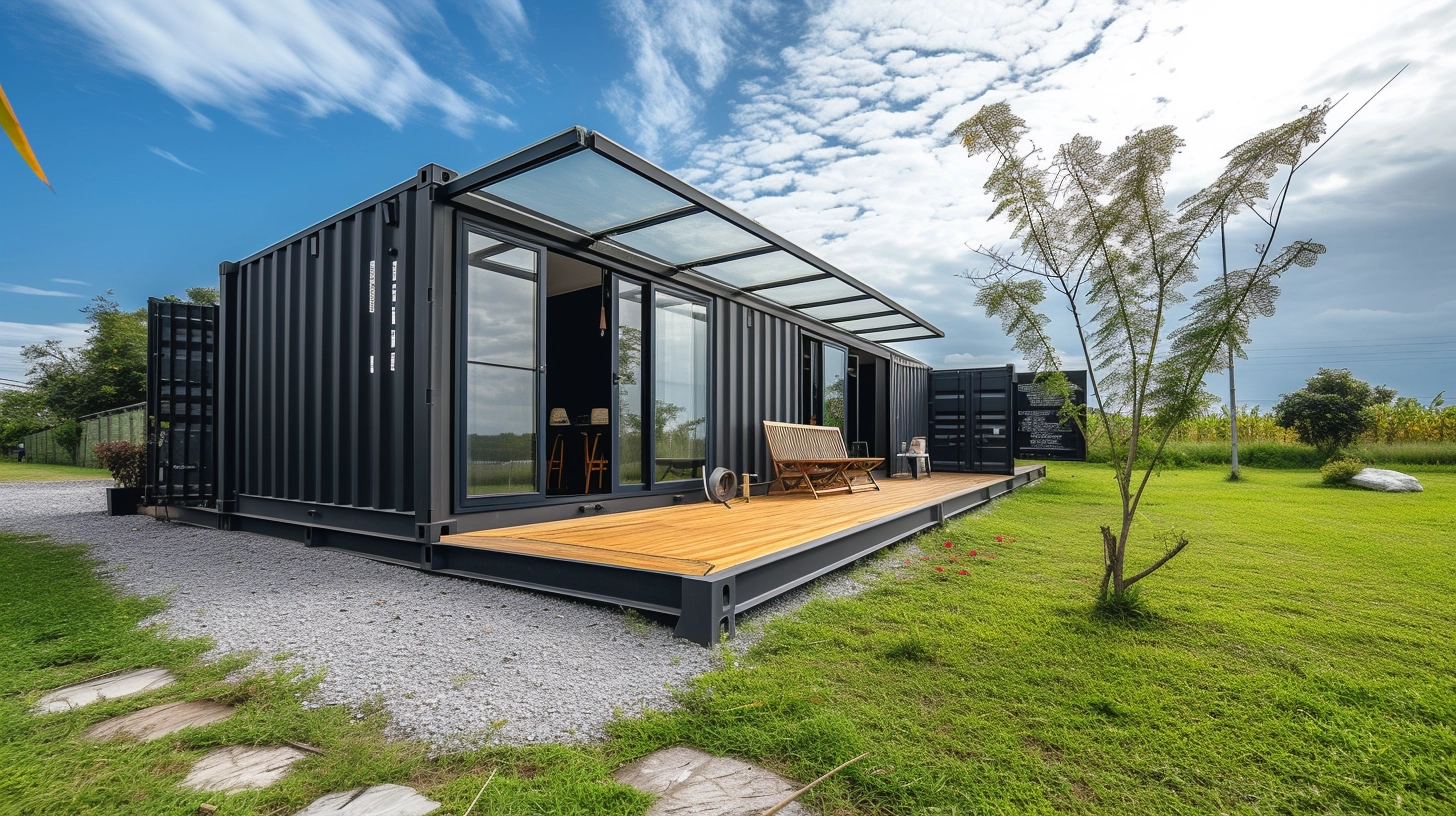You’re dreaming of a unique, eco-friendly home without breaking the bank. Welcome to the world of shipping container homes!
You’ll learn to transform a humble steel box into a high-end, budget-friendly abode. Whether you’re a DIY enthusiast or a design aficionado, you’ll find this guide invaluable.
Ready to start your container home journey? Let’s explore the process, innovative design ideas, and alternative methods.
Get inspired and let’s build your dream home together!
Why choose a Shipping Container Home?
You’re probably wondering why shipping container homes have become such a hot trend.
It’s not just about their sleek, modern aesthetics or the way they challenge traditional ideas about housing.
It’s also about their affordability, durability, and the endless customization options they offer, all of which we’ll delve into next.
Innovation in Affordable Housing
Innovation in affordable housing is something you’ll find intriguing, especially when it’s about building high-end shipping container homes on a budget. Amidst the affordable housing crisis, innovative construction materials, like shipping containers, are stepping up to the plate. These materials aren’t just economical – they’re durable, versatile, and quick to install, embodying the advantages of prefabricated homes.
The tiny house movement has shown us that less can indeed be more, and this holds true with container homes. They’re compact, yet stylish and comfortable, proving that social housing solutions needn’t compromise on quality or aesthetics.
Durability and Sustainability
When it comes to durability and sustainability, there’s no doubt that these eco-friendly alternatives outshine traditional construction methods. Consider using eco-friendly materials like reclaimed wood or recycled steel. Not only are they sturdy, but they also reduce waste. You’re contributing to a healthier planet while crafting an exquisite home.
Opt for energy-efficient designs. Integrated solar panels significantly cut down your utility bills, and they’re a sustainable energy source. Water conservation methods, like installing low-flow fixtures or rainwater harvesting systems, further enhance your home’s efficiency.
Consider sustainable landscaping. Native plants require less water and care, plus they add to your home’s aesthetic appeal. By making these choices, you’re not just building a home; you’re creating a sustainable lifestyle.
Design and Customization Options
Exploring design and customization options, you’ll find that they greatly enhance the uniqueness and functionality of your eco-friendly dwelling. Consider container gardening, where you can grow your own food and herbs, adding a green touch to your home. Opt for eco-friendly paints, free from volatile organic compounds, ensuring your home isn’t just green on the outside.
To optimize energy use, integrate solar panels into your design. This not only reduces your carbon footprint but also your energy bills. Incorporate a rainwater harvesting system, providing a sustainable water source.
Lastly, don’t overlook the charm and sustainability of upcycled furnishings. They’ll not only enhance the appeal of your space but also reduce waste.
With these options, your shipping container home will be a model of eco-friendly efficiency.

Essential Steps in Constructing a Shipping Container Home
Before you dive headfirst into building your shipping container home, there are several steps you mustn’t overlook.
From meticulous planning and finding the perfect size to acquiring necessary permits and preparing your site – each step is crucial.
Planning and Research Importance
You’ll find that thorough planning and research are crucial steps in creating your dream shipping container home without breaking the bank. Budget analysis is your starting point. Know your financial limitations to guide your design decisions.
Then, engage in material sourcing. Look for cost-effective, quality materials. Use research sources like construction guides, online forums, and professionals in the field. These will give you insights on best practices, pitfalls to avoid, and ways to maximize your budget.
Planning tools, such as design software or project management apps, can help organize your project. Additionally, a site assessment is vital. Understand the environment where you’re building. Consider local climate, soil conditions, and zoning laws.
Informed planning and research can lead to a successful, budget-friendly shipping container home.
Choosing the Right Size
Choosing the right size for your future dwelling is an important decision that directly impacts your comfort and cost. When dealing with container pricing, remember that size is a significant factor. Larger containers cost more but provide extra space, while smaller ones are budget-friendly but might limit your design freedom.
Be mindful of size limitations when planning the layout, particularly if you’re considering multiple containers. With stackable options, you can create a multi-level home, maximizing size efficiency. However, this entails additional costs for reinforced structures.
Lastly, don’t overlook transportation logistics. A larger container might seem appealing, but it could complicate and increase the cost of delivery. Therefore, balance your spatial needs, budget, and logistical considerations carefully.
Permit Acquisition Process
Navigating the permit acquisition process can be a bit tricky, but it’s an essential step you can’t overlook when planning your future dwelling. Permit challenges can arise due to varying local regulations, documentation requirements, zoning laws, and building codes. You’ll need to familiarize yourself with these to ensure your project’s success.
Local regulations dictate the types of structures allowed in certain areas, so it’s crucial to understand these laws before proceeding. Documentation requirements vary by location and could include detailed design plans or environmental impact reports. Zoning laws and building codes are designed to protect community aesthetics and safety; failing to comply can result in fines or project delays.
Don’t let the process intimidate you. With patience and careful planning, you’ll secure the necessary permits for your shipping container home.
Site Preparation Essentials
Before you can even think about construction, there’s a crucial step you must tackle – site preparation. It’s not just about clearing the land, it involves detailed planning.
Start with soil testing. It’s essential to understand the composition of the ground you’re building on. This will influence your foundation options. Consider if a traditional concrete slab, pier, or pile foundations best suit your soil type and project budget.
Next, address excavation requirements and drainage solutions. Proper grading of your site will help prevent water accumulation that could damage your home down the line.
Landscaping considerations are also a part of the process. Designing how your outdoor space will interact with your home can influence overall aesthetics and functionality.
Installation and Renovation
You’re now ready to dive into the installation and renovation phase of your project, where you’ll transform your raw materials into a livable space.
Container financing is a crucial aspect of this phase. It’s important to source your containers wisely, considering both cost and shipping logistics. Researching various suppliers can help you secure the best deal.
Once your containers are on-site, it’s time to explore foundation options. You could go for a full basement or a concrete slab; it all depends on your design plan and budget. Remember, a solid foundation is critical for the long-term stability of your home.

Interior Design Ideas for Your Shipping Container Home
Now that you’ve got the structure of your shipping container home down, it’s time to bring your personal touch to the interior.
From choosing an aesthetic that suits your taste, to selecting the right insulation materials, and carefully picking out furniture and decor, you have the opportunity to create a cozy, customized space.
Let’s delve into some interior design ideas to help you transform your shipping container into a unique and comfortable home.
Choosing Aesthetic for Interiors
In selecting the aesthetic for your container home’s interiors, it’s essential to balance style and functionality. Start with color schemes: neutral tones may give a sense of space, while bold colors can add character.
Material selection is crucial too. Opt for durable, low-maintenance materials that add elegance without breaking the bank.
Remember, space optimization is vital in a container home, so choose furniture that’s both stylish and functional.
Consider lighting carefully; it can dramatically alter the ambiance. Combine natural light with strategically placed artificial sources to highlight your home’s best features.
Finally, don’t forget about functional aesthetics. Every element shouldn’t only look good but also serve a purpose.
With careful planning, you can create a stunning, budget-friendly container home interior.
Insulation Options
When it comes to insulation options for your container home, it’s crucial to consider both thermal performance and moisture resistance. You need an insulation type that reduces thermal bridging, the heat transfer that occurs through less insulated parts of your home.
Also, moisture control is vital. Without it, you’ll risk mold, mildew, and structural damage. Vapor barriers can help with this, preventing moisture from penetrating your insulation.
There are various insulation types available, including spray foam, blanket, and panel insulation. Each has its pros and cons, so make sure you do your research.
Furniture and Decor Choices
You’ll find that choosing the right furniture and decor can make a difference in personalizing your space.
A minimalist approach allows your shipping container home to breathe while exuding elegance and simplicity.
Space-saving furniture, such as convertible tables and wall-mounted desks, can maximize your limited square footage.
Rustic decor blends wonderfully with the industrial vibe of a container home. Think reclaimed wood, vintage accents, and earthy tones.
Sustainable furnishings should also be on your radar. Not only are they environmentally friendly, they also add a unique, tactile element to your space.
Customizing to Personal Preferences
Customizing to your personal preferences is key to creating a space that’s truly your own, whether that involves splurging on a designer couch or opting for thrift store finds. With container repurposing, you’re at liberty to craft a unique, eco-friendly living space. From choosing the layout, the insulation to the finishes, every detail can reflect your taste.
Personalized architecture doesn’t have to drain your wallet. Budget-friendly customization is attainable with a bit of research and resourcefulness. Creative carpentry, for instance, can transform affordable materials into stylish and functional pieces.
Exploring Alternative Methods for Shipping Container Home Construction
Now that you’ve got a handle on the interior designs, let’s delve into alternative methods for building your shipping container home.
You’re not limited to do-it-yourself; there are options like turnkey solutions and enlisting the help of a construction team.
Also, consider the variety of uses for your container home – it’s more than just a living space.
Turnkey Solutions
Turnkey solutions offer a fantastic option when you’re looking to streamline your container home construction process without breaking the bank. You can enjoy a hassle-free experience with turnkey providers who handle everything, from cost evaluation to maintenance aspects.
Financing options are available, making it easier to manage your budget. These providers offer a detailed breakdown of costs, eliminating any hidden surprises. They also ensure quality control, reducing long-term maintenance costs.
Furthermore, turnkey solutions consider resale value. While you may love your shipping container home, future buyers might’ve reservations. Turnkey providers address these concerns, designing homes to appeal to a broad market. This approach can boost resale potential, giving you peace of mind for your investment.
Construction Team Assistance
You’ll find that having a dedicated construction team on board can make the process of creating your dream dwelling a lot more manageable. Team selection is crucial. You need professionals with the right skill requirements who understand the nuances of working with shipping containers.
A good team will also handle project management, ensuring that every element, from design to execution, runs smoothly. They’ll provide a cost estimation, helping you stay within your budget. Plus, they’ll adhere to essential safety measures, preventing costly accidents and ensuring a secure site.
The right construction team won’t just build your home, they’ll guide you through the entire process, making sure that your vision becomes an affordable reality.
Container Home Uses
Beyond just a place to live, container homes can serve a variety of uses that might surprise you. Picture this: a lush container garden on your rooftop, where you can grow your own food. You’re not just repurposing materials, but also reducing your carbon footprint. Eco-friendly insulation keeps your home warm in winter, cool in summer, and your energy bills low.
Perhaps you’ve dreamed of off-grid living? With container mobility, you can transport your home to a secluded spot, harnessing solar or wind power. You’re not tied to one place or dependent on public utilities.
In essence, a container home isn’t just a budget-friendly choice; it’s a versatile, sustainable solution. It’s about more than saving money – it’s about changing your lifestyle.
Frequently Asked Questions
How Do You Insulate a Shipping Container Home to Make It Suitable for Different Climates?
You’ll need to use insulation materials like spray foam for climate adaptability. It prevents condensation issues, increases energy efficiency and tackles thermal bridging. This makes your shipping container home suitable for different climates.
Can Shipping Container Homes Be Expanded After Initial Construction?
Yes, you can expand your shipping container home after initial construction. Container customization allows for design modifications, but consider expansion costs, structural integrity, and extra space utilization carefully.
What Are the Legal Requirements or Permits Needed to Build a Shipping Container Home?
You’ll need to adhere to zoning regulations, secure permits for container modifications, and pass safety inspections. Permit costs vary, so check local ordinances. It’s crucial to know your local laws before construction.
How Long Does the Construction Process of a Shipping Container Home Typically Take?
You’d typically spend 2-3 months constructing a shipping container home. Durability of containers, design flexibility, interior design choices, sourcing containers, and eco-friendly construction methods can all affect the timeline.
Can Shipping Container Homes Be Built on Any Type of Land or Are There Specific Requirements?
You can’t just plonk a container home on any land. It’s crucial to conduct a land assessment, consider foundation options, check soil compatibility, address terrain challenges, and take into account flood zone considerations.
Conclusion
Crafting a high-end shipping container home on a budget is achievable. With careful planning, innovative design, and alternative construction methods, you can create a stylish, functional home. Remember, it’s not just about the structure, but the life you’ll lead within.
Your creativity can make any space, no matter the size or materials, truly yours. So go ahead, take the leap, and start building your dream shipping container home today.
